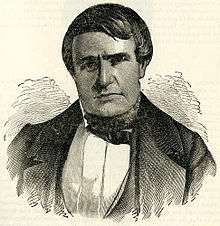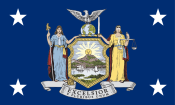John Young (governor)
John Young (June 12, 1802 – April 23, 1852) was an American politician. He served in the United States House of Representatives and as Governor of New York.
John Young | |
|---|---|
 | |
| 15th Governor of New York | |
| In office January 1, 1847 – December 31, 1848 | |
| Lieutenant | Addison Gardiner Hamilton Fish |
| Preceded by | Silas Wright |
| Succeeded by | Hamilton Fish |
| Member of the U.S. House of Representatives from New York's 30th district | |
| In office November 9, 1836 – March 3, 1837 | |
| Preceded by | Philo C. Fuller |
| Succeeded by | Luther C. Peck |
| In office March 4, 1841 – March 3, 1843 | |
| Preceded by | Luther C. Peck |
| Succeeded by | William Spring Hubbell |
| Personal details | |
| Born | June 12, 1802 Chelsea, Vermont |
| Died | April 23, 1852 (aged 49) New York City, New York |
| Political party | Whig |
| Spouse(s) | Ellen Harris |
| Profession | Attorney Politician |
Early life
Young was born in Chelsea, Vermont on June 12, 1802. As a child, his family moved to Freeport (now Conesus), Livingston County, New York, where his parents operated an inn. He had only basic schooling but by self-study acquired an education in the classics which enabled him to qualify as a schoolteacher, after which he taught in Livonia, New York. He later studied law with Augustus A. Bennett of East Avon, New York, and Anbrose Bennett of Geneseo, New York. Young was admitted to the bar in 1829, and began a practice in Geneseo.
Among the prospective attorneys who later studied under Young was his brother in law James Wood, and Young and Wood later formed a partnership.
Start of career
He entered politics as a Jacksonian Democrat, but shortly afterward joined the Anti-Masonic Party. He was a member of the New York State Assembly (Livingston Co.) in 1832.
Young was elected as a Whig to the 24th United States Congress, to fill the vacancy caused by the resignation of Philo C. Fuller, holding office from November 1836 to March 3, 1837. In 1840 he was elected to the 27th United States Congress, holding office from March 4, 1841, to March 3, 1843.
He was again a member of the Assembly (Livingston Co.) in 1845 and 1846.
Governor of New York
In 1846 Young was the Whig nominee for governor. He defeated incumbent Silas Wright and served one term, January 1847 to December 1848.
As governor, Young favored expanding the Erie Canal, oversaw establishment of the state court of appeals, and opposed the Mexican War. He also pardoned farmers who had been imprisoned for participating in the Anti-Rent War.
In 1848 Young was defeated for the Whig nomination for governor by Hamilton Fish, who went on to win the general election.
Later career
In 1848 Young was a delegate to the 1848 national convention. He first backed Henry Clay for president, but supported Zachary Taylor after Taylor was nominated. After Taylor assumed office he rewarded Young with the appointment as Assistant Treasurer of the United States in New York City. Young served until his death in New York City from tuberculosis on April 23, 1852. He was buried at Temple Hill Cemetery in Geneseo.
Family
In 1833 Young married Ellen Harris of York, New York. They were the parents of four children.
Sources
- United States Congress. "John Young (id: Y000042)". Biographical Directory of the United States Congress.
| Party political offices | ||
|---|---|---|
| Preceded by Millard Fillmore |
Whig nominee for Governor of New York 1846 |
Succeeded by Hamilton Fish |
| U.S. House of Representatives | ||
| Preceded by Philo C. Fuller |
Member of the U.S. House of Representatives from New York's 30th congressional district 1836–1837 |
Succeeded by Luther C. Peck |
| Preceded by Luther C. Peck |
Member of the U.S. House of Representatives from New York's 30th congressional district 1841–1843 |
Succeeded by William Spring Hubbell |
| Political offices | ||
| Preceded by Silas Wright |
Governor of New York 1847–1848 |
Succeeded by Hamilton Fish |
